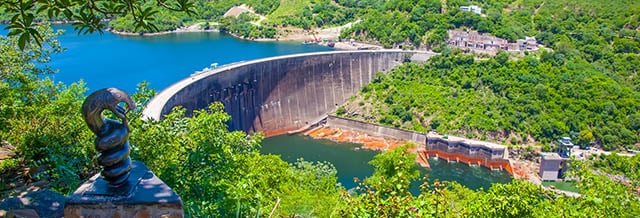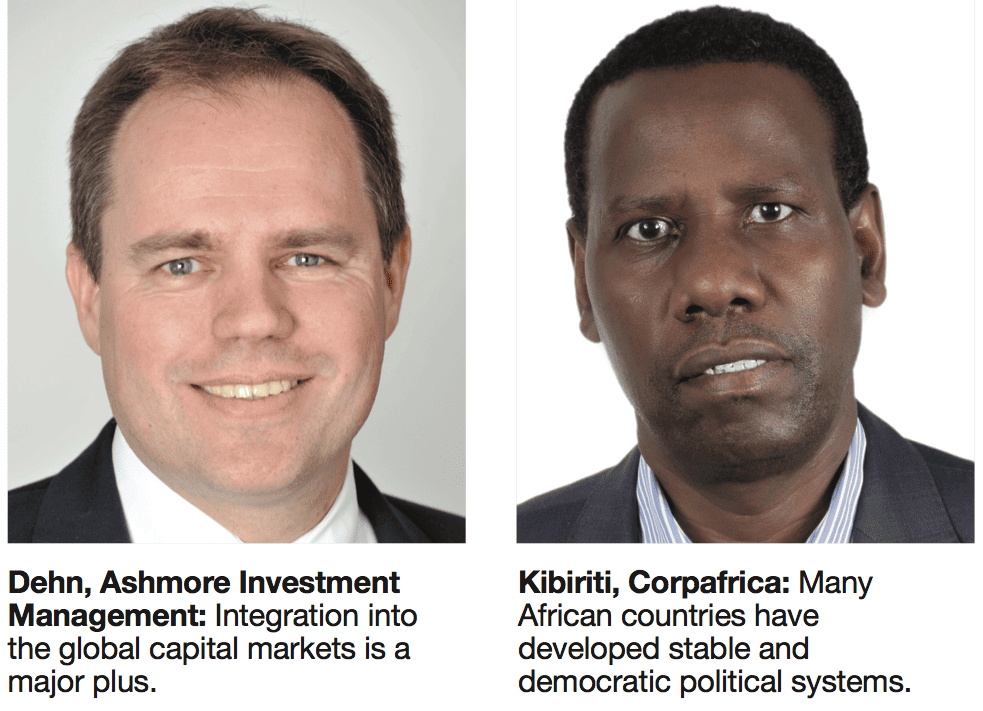Africa’s story is no longer that of a continent with great potential. Increasingly, the leaders and peoples of the continent, in collaboration with outsiders, are translating that potential into concrete achievements.

Between 2010 and 2014, sub-Saharan Africa averaged annual growth of 5.3%, considerably better than the world average of 3.9% in the same time period and far better than the average of just 1.8% among the G7 economies. Indeed, only developing Asia has grown faster than sub-Saharan Africa over the past five years, at 7.4%, buoyed largely by China. And China gained a significant economic boost from its incursion into Africa, which today provides part of the fuel that keeps the Chinese economy running. However, as China slows, it could have an impact on African investment and thus the growth picture for some African economies.
Nonetheless, since the onset of the global financial crisis, sub-Saharan Africa’s collective economy has grown by 80%, from around $935 billion in 2007 to over $1.6 trillion last year, according to Simon Freemantle, senior political economist at Standard Bank Group.
MORE THAN MINERALS
Some observers argue investors are moving into Africa just to take advantage of the continent’s vast mineral wealth. But that’s not necessarily the case, argues Peter Kibiriti, CEO of Corpafrica, a financial advisory firm in Kenya. If it were, Rwanda, which has virtually no mineral wealth, would be at the bottom of the list of African countries in terms of the level of foreign direct investment (FDI) received in recent years, Kibiriti points out.
Instead, Rwanda saw $159.8 million in foreign direct investment in 2012 and $110.8 million in 2013, according to World Bank data. In resource-rich but crisis-torn Central African Republic, the corresponding figures were $71.2 million and $800,000, respectively.
“Rwanda’s attractiveness stems from its extremely open economy and strategic location within Eastern Africa,” Kibiriti says. “Notwithstanding the fact that the sociopolitical and economic environment is very welcoming, savvy investors are locating in Rwanda with an eye on the regional markets in Southern and Central Africa.”
The gains made by African economies reflect both political and economic factors. The origins of the African renaissance are nearly 25 years in the past, says Jan Dehn, head of research at Ashmore Investment Management, an emerging-markets fund manager.
“The end of the Cold War ushered in far more local accountability through democracy in various shapes and sizes,” Dehn says. “African governments now need to keep their economies stable and growing in order to win reelection.”
Today, a majority of African countries have developed or are developing “fairly stable and democratic political systems,” Kibiriti says. The vote has replaced the gun as a means of changing governments.
LEADING REFORMERS
Rwanda and Mauritius are the shining stars of the reform movement sweeping through Africa. The changes they’ve made, and similar changes occurring across Africa, are now attracting swarms of investors from around the globe.
Just 20 years after it was decimated by the 1994 genocide, Rwanda has experienced a meteoric rise in economic performance that has attracted international attention. It is today considered one of the choice destinations for investors, with the Chinese among those putting money to work.
Reforms in Rwanda were not piecemeal but broad-based, involving a political, social and economic transformation. As part of the effort, the country reviewed existing commercial laws and drafted new ones.
“The main reason for Rwanda’s ascent to the status of darling of the West is that the economy has recovered strongly on the back of market-friendly policies, while the political landscape has been stable due to strong leadership by president Paul Kagame,” Dehn says.
In Mauritius, the government abolished foreign exchange controls in 1994. Investors can repatriate profits, dividends and capital gains without having to seek approval.
More recently, Mauritius initiated wide-ranging reforms following the end of trade preferences on its two major exports, sugar and textiles. It opened up the economy, permitting foreign ownership in all sectors, although in regulated industries, it set limits, capping foreign ownership in broadcasting, for example, at 20%.
The country’s efforts suffered a setback recently, though, when the government accused a major bank, Bramer, of running a Ponzi scheme and revoked its license.
OTHER STAR PERFORMERS
Rwanda and Mauritius are by no means the only sterling performers. The continent’s stars over the past few years are the countries that have sustained robust annual growth along with broad political and macroeconomic stability, Freemantle says.
These include Ethiopia, which grew at an average rate of 9.7% between 2010 and 2014; Kenya (6.1%); Mozambique (7.4%); and Tanzania (6.9%). Others grew at equally impressive rates, such as Nigeria (6.4%), Zambia (7.3%) and Ghana (8.7%), but experienced less policy and political stability over the period.
According to the World Bank, African nations feature prominently among the ranks of reformers. Between June 2013 and June 2014, 189 countries recorded 230 regulatory reforms aimed at making it easier to do business.
Sub-Saharan Africa accounted for the largest chunk of those business reforms, with 75 out of the 230. According to the World Bank, more than 70% of the region’s economies undertook at least one such reform, with sub-Saharan Africa accounting for five of the 10 top improvers from 2013 to 2014: Togo, Benin, Côte d’Ivoire, Senegal and the Democratic Republic of Congo.
Morever, the bank’s Ease of Doing Business list ranks Mauritius 28th out of 189 countries, with Rwanda coming in 46th and Ghana 70th.
DIVERSIFICATION
Reforms and diversification complement each other, and both are aimed at the same purpose: to make the economy perform better. Mauritius’s diversification from a one-crop economy has been a driving force, while in Rwanda, the government has worked to broaden the base of the economy.
There are two keys to diversification for countries that depend heavily on a single commodity, Dehn says. The first is to ensure efficient management of their earnings by saving windfalls from commodities to avoid a boom-bust dynamic and “Dutch disease”—when the demand for a country’s natural resources strengthens its currency to the extent that its manufacturing sector becomes less competitive.
The second key is for governments to resist a slide into dictatorship. “It is tempting for governments that control cash-generating sectors such as oil to use the windfall to amass power in the president and dismantle the other institutions that provide checks and balances,” Dehn notes.
Across the continent, previously made up of countries that largely supplied raw materials, diversification is being driven by a growing intraregional trade.
Several years of attempts at regional integration are bearing fruit, notes Kibiriti, as evidenced by a significant number of cross-border investments by nationals of the various regional trading blocs, notably the East African Community, the Common Market for Eastern & Southern Africa, the Southern Africa Development Community and the West Africa Economic Monetary Union.
Taking advantage of regional integration (including opportunities for cross-listing in regional stock markets), Kenya’s leading indigenous enterprises, such as Kenya Commercial Bank, Chandaria Industries and UAP Insurance, have made multimillion-dollar investments in Uganda, Tanzania, Rwanda, Burundi and South Sudan. That group of nations represents a market of over 100 million people, according to Kibiriti. Also targeting this market are banks and manufacturers from South Africa and Nigeria, as well as investors from outside Africa.

NEW FOCUS FOR INVESTMENTS
Traditionally, investment into Africa mostly involved extractive industries, as well as the infrastructure required to move mined resources to ports for export, Freemantle points out. This is changing as the continent’s manufacturing and services base begins to mature and expand, Freemantle notes. Some of the most compelling investment opportunities in Africa’s emerging and frontier economies are in consumer-facing industries, including consumer goods, financial services, telecommunications and pharmaceuticals.
Portfolio flows to Africa have also grown as the appetite for African debt and equity has lifted, in part in response to the low interest rate environment in the advanced world. Investment flows into the continent have also been supported by the improved macroeconomic management and political stability in some of Africa’s key markets.
From Nigeria to Kenya and Zimbabwe, stock market reforms are generating interest among foreign investors. “We have seen an increased interest in investing in Africa as a result of reforms,” says Duncan Smith, senior business development manager at Société Générale Securities Services in South Africa.
Nigeria has been “a huge success story,” Smith says, driven in part by Nigerian companies, like Seplat Petroleum Development, with dual listings on the Nigerian Stock Exchange and London Stock Exchange, and by Nigeria’s registration of foreign collective investment schemes and its five-year exemption of stock market transactions from value-added tax.
Nigeria now is developing a 10-year capital market master plan, which it plans to implement beginning this year.
Zimbabwe too has seen increased flows of FDI following the establishment of the Chengetedzai Depository, the country’s first central securities depository, in 2014. The dematerialization of securities and the settling of trades in US dollars reduce risk, making the market more attractive, Smith says.
GLOBAL ISSUANCE
African economies are also becoming increasingly integrated into the global capital markets for the first time. This has been a major development for three reasons, says Ashmore’s Dehn.
First, it helps countries to diversify their financing sources away from development assistance. For the first time, many African countries have issued international bonds to finance projects at home. In 2011, Nigeria sold its first eurobond, raising $500 million. In 2013, Rwanda sold its first international bond, raising $400 million to finance the construction of a hydropower plant and a hotel, and payment of some of state-owned RwandAir’s debt.
Integration into the global financial markets has brought more market discipline to government finances. Countries now are able—or forced—to manage public finances better and reduce fiscal deficits to acceptable levels. Many African nations, especially those endowed with natural resources, have set up sovereign wealth funds into which they pay excess revenues from commodities prices that exceed benchmarks. Nigeria and Angola are two countries that have established such funds.
Integration is paving the way for full market access for African corporates. Private-sector companies now are also able to raise funds from the global financial markets, with their respective countries’ debt instruments helping them price their own risks.
While sub-Saharan Africa has made great strides, the outlook still contains clouds. Some countries continue to be plagued by political instability and strife. And some have been hit hard by the plunge in the price of oil and other commodities. But that hit from commodities may encourage more economic diversification across the continent, to the benefit of all.



